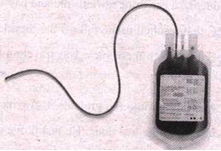题目内容
B

We all know donating blood provides a vital lifeline to those in need,but a growing body of research suggests that it could have health benefits for the donor too.
Findings have shown that donating blood reduces the risk of heart attacks and even cancer.
It even bums quite a bit of energy — 650 calories(卡路里) for every pint (568 ml) given.
The news could come as a promotion (宣传) of British blood banks which use an average of 7 ,000units of blood every day.
It is thought that the benefits arise from- lowering high iron levels.
Iron affects how thick and sticky the blood is. High iron levels cause the blood to be thicker.
Raised iron levels also keep blood from flowing smoothly.
Because donating blood removes some of its iron,it may therefore have a protective benefit if done on a consistent basis by helping thin the blood.
According to a study from the Journal of the American Medical Association,researchers found that those aged 43 to 61 had fewer heart attacks when they donated blood every six months.
A study of 2 ,682 men from Finland found they had an 88 percent reduced risk of heart attacks than those who didn,t donate,reported Medical Daily.
Likewise,a study published in the Journal of the National Cancer Institute also links iron to an increased cancer risk.
The four-and-a-half-year study involving 1,200 people found those who made blood donations twice a year had a lower risk of cancer and death than those who didn’t.
However,these benefits depend on making donations on a regular basis,rather than once in a while.
Another side effect of donating blood is that it can bum a large number of calories too .
The University of California in San Diego says that for every one pint of blood donated,650 calories are burned as the body must fill itself up.
Although this seems to be an attractive effort-free way to lose weight,the NHS Blood and Transplant centre still encourages people to donate for the benefit of others first,rather than for themselves.
6. How can giving blood prevent heart disease?
A. By keeping blood from flowing fast.
B. By increasing blood's thickness.
C. By reducing iron in the blood.
D. By helping iron work better.
7. What is the healthiest way to donate blood?
A. Give blood regularly.
B. Give blood every six months.
C. Make donations in middle age.
D. Donate a small amount each time.
8. The author mentions the three studies to.
A. prove the serious harm of cancer
B. solve the problems of giving blood
C. explain the reasons for heart disease
D. show the benefits of blood donations
9. According to the NHS Blood and Transplant centre,donating blood .
A. is an attractive way to lose weight
B. should be based on selflessness
C. involves some degree of risk
D. may bum too many calories
10. Which of the following can be the best title?
A. Blood donation is vital to the receiver
B. Giving blood is good for your health
C. Donating blood helps prevent heart attacks
D. Giving blood has proven to be completely safe
B篇(健康)
本文是说明文。研究显示,献血对健康有益,有助于预防心脏病和癌症。
6. C. 细节理解题。由第五段的It is thought that the benefits arise from lowering high iron levels可知,献血能够减少血液中的铁,从而能够预防心脏病。
7. A. 细节理解题。由第八段中的it may therefore have a protective benefit if done on a consistent basis by helping thin the blood和倒数第四段的However,these benefits depend on making donations on a regular basis,rather than once in a while 可知,有规律地献血对健康最有益。
8. D. 推理判断题。文章第九段至第十一段提到的三项研究都证明了献血对健康有益。
9. B. 推理判断题。由最后一段可知,该中心提出,献血应该建立在无私奉献的基础之上,不要为了个人减肥的目的而献血。
10. B. 标题妇纳题。本文报道了几项证明献血有益的研究。B项准确地概括了文 章主旨。
